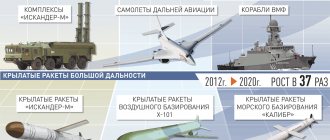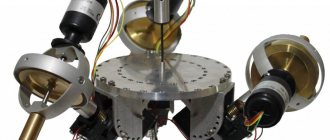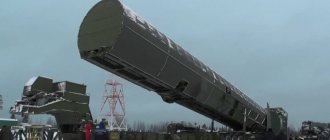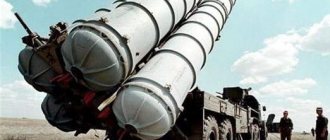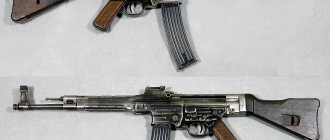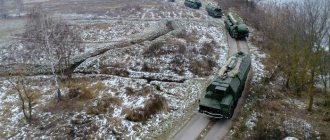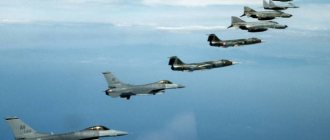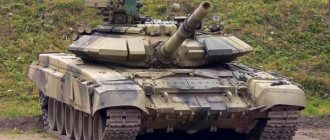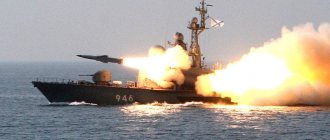CRUISE MISSILE
Rice. 1. A cruise missile made according to an aircraft design.
Rice. 2. Launch (a) of an air-to-surface cruise missile and diagram of its flight trajectory (b): 1 – low-altitude part of the trajectory; 2 – trajectory at the target.
Rice. 3. Diagram of the Kh-35 anti-ship cruise missile: 1 – homing head; 2 – warhead; 3 – automatic self-destruction system; 4 – inertial control system...
CRUISED MISSILE (CR), an atmospheric unmanned aerial vehicle equipped with wings, an engine (jet or rocket), and a target guidance system; designed for high-precision destruction of ground and sea targets. The missile launchers can be placed on both stationary and mobile launchers (ground-based, air-based and sea-based). Basic distinguishes KR features: high aerodynamic. characteristics; maneuverability; the ability to set an arbitrary course and move at low altitude along the bends of the terrain, which makes them difficult to detect by enemy air defense systems; high-precision target destruction [circular probable deviation (CPD) modern. KR does not exceed 10 m]; the ability, if necessary, to adjust the program flight path using the on-board computer and automatic system. control (BSAU). Depending on the relative position of the load-bearing and control surfaces, the missile launcher can have aircraft or rocket aerodynamics. diagram. Therefore, in a broad sense, missiles include almost all types of guided missiles (aircraft, anti-aircraft, anti-ship and anti-tank). In a narrow sense, missile launchers mean missiles made according to an aircraft design (Fig. 1). CDs are divided: according to firing range and the nature of the tasks being solved - into tactical (up to 150 km), operational-tactical (150–1500 km) and strategic (over 1500 km); according to flight speed - sonic and supersonic; by type of basing - ground, air, sea (surface and underwater); by type of warhead (warhead) - nuclear and conventional (high-explosive, cluster, etc.); for combat purposes - “air-to-surface” (Fig. 2) and “surface-to-surface” classes.
The missile launcher consists of a body (fuselage) with load-bearing and control surfaces (wing, rudders, stabilizers, etc.), an engine, an installation, on-board control equipment and a warhead. The KR is welded metal or made of composites. body materials, b. h. internal the volume of which is a fuel tank. Before the rocket is launched, the wings are folded and open after the ejection launcher is activated. Propulsion system of land and sea missile systems. basing consists of a launch accelerator and a propulsion engine. The latter can be used as a rocket (liquid or solid propellant) or air-breathing engine. The starting accelerator is, as a rule, a solid-fuel jet engine (air-based missiles do not have one). The engine has automatic electronic-hydraulic a control system that ensures changing its modes and adjusting thrust during the flight of the rocket. The basic composition of modern equipment. KR includes: inertial navigation system; altimeters; route correction systems (including using a global satellite navigation system); homing head; automatic system self-destruction; a system for exchanging information between salvo missiles; on-board computer; In addition to the autopilot function, the BSAU also includes the ability to perform maneuvers by the missile to counter interception. A typical RC diagram is shown in Fig. 3.
The prospects of this weapon were drawn to the attention of S.P. Korolev, who developed a series of experiments in 1932–38. KR (217/I, 217/II, etc.); Ground and flight tests were carried out, confirming the design characteristics, but the autopilot turned out to be unable to provide proper flight stabilization. The first CD (they were called unmanned projectile aircraft) V-1 were developed and used by Germany in the end. World War 2 (prototype tested in December 1942, first combat use in June 1944). In the USSR, since 1943, the KR 10X was tested on Pe-8 and then Tu-2 bombers, but it did not receive combat use in the war. In the 1950s–60s. in the USSR (the term “KR” was introduced in the USSR in 1959) and the United States, a number of KRs were created. Among them: in the USSR - KS-1 “Comet” (the first missile-guided aircraft in the USSR; launched in 1952), P-15, X-20, KSR-11, X-66, etc.; in the USA - “Matador”, “Regulus-1”, “Hound Dog” and others. The missile launchers of this generation were not widely used because they were heavy and bulky (launching weight 5.5–27 tons, length 10– 20 m, hull diameter 1.3–1.5 m), in addition, there was no effective guidance system. The first missile launch vehicle with an underwater launch was the Sov. homing missile launcher "Amethyst" (1968). Revival of interest in CD in the 1970s. and the creation of a new generation CD is due to technical. achievements that have made it possible to significantly improve guidance accuracy, reduce overall dimensions and place them on mobile launch platforms. One of the most popular foreign missile launchers is the Tomahawk (USA). This missile began to enter service in 1981 in several versions: strategic ground-based (BGM-109 G) and sea-based (BGM-109 A) with a nuclear warhead (there is a similar aircraft missile AGM-86 B); operational-tactical naval basing BGM-109 C and BGM-109 D, respectively, with semi-armor-piercing and cassette warheads; tactical marine basing BGM-109 B with a high-explosive warhead. To modern father strategic The Kyrgyz Republic includes the Kh-55 (air-based) and Granit (sea-based).
Basic flight technical The characteristics of some CDs of the Russian Federation and the USA are presented in the table.
Basic flight characteristics of some cruise missiles
| Type | Class | Purpose | Length, m | Case diameter, m | Wingspan, m | Starting weight, kg | Weight of warhead, kg | Flight range, km | Flight speed, m/s | Altitude on a low-altitude trajectory - at the target, m |
| X-35 (RF) subsonic | Short range, universal | Anti-ship | 3,75 | 0,42 | 1,17 | 480–600 | 145 | 5–130 | 145–300 | 10–3 |
| "Moskit" (RF) supersonic, homing | Short range, universal | Anti-ship (detected 3-4 s before hitting the target) | 9,385 | 0,76 | 2,1 | 3950–4500 | 320 | 10–250 | up to 800 | 20–7 |
| Onyx (RF) supersonic | Medium range, universal | Anti-ship | 6,1 | 0,7 | 1,7 | 2500 | 200 – 250 | up to 300 | up to 800 | 15 – 5 |
| 3M-54E (RF) supersonic | Medium-range, air-to-surface | Anti-ship | 8,22 | 0,514 | 3,0–3,3 | 2275 | 200 | up to 320 | 220 –990 | 20 –5 |
| X-55 (RF) subsonic | Long range, air-to-surface | Strategic | 5,88 | 0,556 | 3,1 | 1300 | 410 | 2500 | 260 | 110-40 |
| AGM-86 ALCM (Air-Launched Cruise Missile, USA) | Long range, air-to-surface | Strategic | 6,32 | 0,62 | 3,66 | 1450 | 900 | 2700 | 220-334 | 100-20 |
| "Tomahawk" (BGM-109 "Tomahawk", USA). Modifications: A, B, C, D, E | Long range, universal | A, C, D – (for destroying underground launchers), B, E – tactical (for destroying surface ships) | 6,25 | 0,52 | 2,62 | 1450 –1500 | 120 | 2500 (BGM-109A); 900 –1250 (BGM-109C/D) | 232-334 | 100-20 |
When developing a new generation missile launcher, much attention is paid to the creation of long-range missile launcher control systems that provide a CEP of 3–10 m with an equipment weight of up to 100 kg. Reducing the visibility of the radar is ensured by the choice of low-reflective geometries. forms, the use of radio-absorbing materials and coatings, special devices for reducing the effective scattering surface, antenna devices and air intakes. Of the conventional warheads that are used on high-precision missiles to destroy various types of warheads. purposes, multi-factor warheads (high-explosive-cumulative with a penetrating effect) weighing 250–350 kg are widely used. The latest achievements in the field of microelectronics, propulsion systems, highly efficient fuels and structural materials ensure the development of supersonic, high-precision, stealth missiles with a range of up to 3,500 km, weighing no more than 1,500 kg.
Differences in hypersonic flow
But why was the hypersonic region differentiated from the supersonic region? How does it differ from supersonic and why was the boundary drawn precisely at five times the speed of sound, at M = 5? This boundary has a physical meaning, because beyond it the flow becomes different.
In supersonic flight
the oncoming flow is partially slowed down by the apparatus, compressing against it and becoming denser. Compression increases the temperature of the air, and the stronger it is, the hotter the compressed air. The flow is slowed down most strongly on the parts of the apparatus that encounter air. Therefore, the leading edges of the wings, stabilizers and fin, and other parts protruding into the flow are heated to several hundred degrees, for example, to 330 ° C at M = 3. A supersonic impact on an obstacle seems to split the high supersonic speed into myriads of tiny movements of molecules, small and multidirectional. Such a fine grinding movement converts kinetic energy into internal energy, creating heat. The increase in molecular movement becomes heat, increasing the temperature. But this heating is not reflected in any way in the air molecules themselves, which fly in simple points and collide with each other with increasing force.
flow
speed increases the impact of molecules. At M = 5, collisions are reflected in the molecules themselves. Two atoms in the molecules of the main gases of air, nitrogen and oxygen, begin to resonate and vibrate, moving closer and further apart. This is a new, vibrational movement that has climbed inside the molecule. The enormous speed of the hypersonic flow intensifies the impact on the obstacle and its grinding, crushing the kinetic energy before transforming into even smaller forms of motion - intramolecular. They add their energy to the molecule along with the energy of another new movement that begins to manifest itself - the rotation of molecules. These innovations add to the heat capacity of gas, storing more and more heat and increasing the energy of processes.
Energy pumping
weakens the bonds of atoms moving further away from each other in vibrations, and the molecules begin to disintegrate. Free atoms enter into new compounds - chemical reactions occur. They multiply, fueled by the energy of the flow and the catalytic effects of the materials of the apparatus. Atoms lose electrons, plasma appears, and its concentration increases. The shock wave from the nose and leading edges bends more and more and falls on the body, covering the entire aircraft. The wave merges with the surface layer, forming a single viscous shock boundary layer. The gas, which is no longer ideal, flows in cascades of nonequilibrium states, with high-frequency waves of instability and other complications. To adequately describe what is happening, extensive mathematical constructions and hundreds of specific variables are required. Their values change all at once, simultaneously with temperatures, pressures and concentrations, energies and balances of reactions and many other factors. All this is richly flavored with radiation and absorption in the range from thermal to ultraviolet and shines brightly from the surface of the device, strikingly different from simple supersonic compression and heating.
Half-tone hammer drill
In Syria, Russian aviation mainly uses standard high-explosive free-fall bombs of 250 and 500 kilogram caliber, as well as special concrete-piercing bombs BETAB-500, including active-reactive bombs with increased capabilities for overcoming obstacles - BETAB-500ShP. High-explosive bombs contain a large amount of explosives - from 150 to 350 kilograms, which ensures reliable destruction of the target. However, large-caliber high-explosive bombs have a significant damage radius, so in Syria they are used against relatively large, structurally sound objects located remotely from urban areas. Concrete-piercing bombs, capable of penetrating up to three to four meters of concrete floors (depending on the quality of the concrete), are used to destroy especially protected underground structures. These are mainly strategic and operational command posts, as well as large weapons depots.
How are rockets different?
Now we can talk about how rockets differ from each other. As a rule, ordinary people hear references to cruise and ballistic missiles. These are really the two main types, but there are some others. Let's look at the main ones, but first I will give a classification of types of missiles.
Rockets are divided into types depending on:
- Flight trajectories (winged, ballistic)
- Class (ground-to-air, air-to-ground, air-to-air and so on)
- Flight ranges (short/medium range and intercontinental)
- Engine type and fuel type (solid fuel, liquid, hybrid, ramjet, cryogenic)
- Warhead type (conventional, nuclear)
- Guidance systems (laser, fly-by-wire, command, geophysical, ground-based, satellite and others)
Countless types of missiles.
Now let's look in more detail at the main points that may seem incomprehensible.
